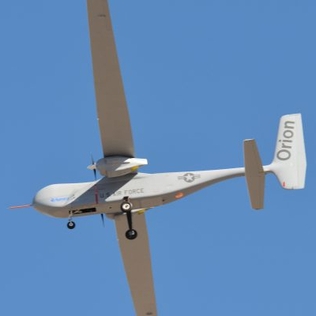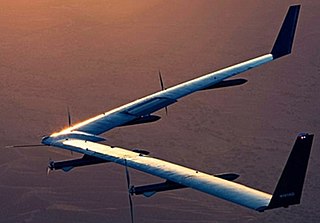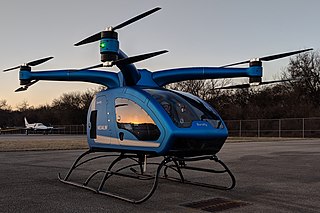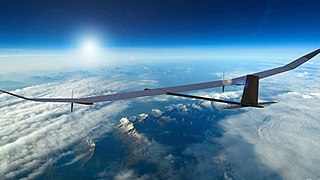| Odysseus | |
|---|---|
 | |
| Role | HALE UAV |
| National origin | United States |
| Manufacturer | Aurora Flight Sciences |
The Odysseus is a solar, High-Altitude Long Endurance drone developed by Aurora Flight Sciences.
| Odysseus | |
|---|---|
 | |
| Role | HALE UAV |
| National origin | United States |
| Manufacturer | Aurora Flight Sciences |
The Odysseus is a solar, High-Altitude Long Endurance drone developed by Aurora Flight Sciences.
Aurora Flight Sciences announced the Odysseus in November 2018. [1] In spring 2019, Aurora planned to fly a High-Altitude Long Endurance drone powered by solar cells and batteries, Odysseus, to study the Earth atmosphere or as a military pseudo-satellite for intelligence, surveillance and reconnaissance. [2] The 74.1 m (243 ft) wide carbon fibre aircraft should weigh less than a 880 kg (1,940 lb) Smart Car, can carry a 25 kg (55 lb) payload with 250W provided during several months of endurance. [2] It would compete with the Airbus Zephyr ordered by the UK Ministry of Defence and visited by the U.S. Army Futures Command, the BAE Systems-Prismatic Ltd UAV, and the AeroVironment-SoftBank telecommunications UAV. [2] The bendable wing has fiberglass upper skin panels and plastic film undersides, three tails and six propellers, with roll controlled by the outboard tails. [3] It used available, low-risk, lithium polymer batteries and gallium arsenide thin-film solar cells and first test flights were to be powered by batteries only. [3] It was designed to stay day and night above 65,000 ft (20,000 m) up to three months at latitudes up to 20°. [4] First flight was planned for April 2019 in Puerto Rico, before investigating ozone depletion in the summer over the US Midwest. [4] Its first flight was indefinitely delayed by July 2019. [1]

An unmanned aerial vehicle (UAV), commonly known as a drone, is an aircraft without any human pilot, crew, or passengers on board. UAVs were originally developed through the twentieth century for military missions too "dull, dirty or dangerous" for humans, and by the twenty-first, they had become essential assets to most militaries. As control technologies improved and costs fell, their use expanded to many non-military applications. These include aerial photography, precision agriculture, forest fire monitoring, river monitoring, environmental monitoring, policing and surveillance, infrastructure inspections, smuggling, product deliveries, entertainment, and drone racing.

The NASA Pathfinder and NASA Pathfinder Plus were the first two aircraft developed as part of an evolutionary series of solar- and fuel-cell-system-powered unmanned aerial vehicles. AeroVironment, Inc. developed the vehicles under NASA's Environmental Research Aircraft and Sensor Technology (ERAST) program. They were built to develop the technologies that would allow long-term, high-altitude aircraft to serve as atmospheric satellites, to perform atmospheric research tasks as well as serve as communications platforms. They were developed further into the NASA Centurion and NASA Helios aircraft.

AeroVironment, Inc. is an American defense contractor headquartered in Arlington, Virginia, that designs and manufactures unmanned aerial vehicles (UAVs). Paul B. MacCready Jr., a designer of human-powered aircraft, founded the company in 1971. The company is best known for its lightweight human-powered and solar-powered vehicles. The company is the US military's top supplier of small drones —notably the Raven, Switchblade, Wasp and Puma models.

An electric aircraft is an aircraft powered by electricity. Electric aircraft are seen as a way to reduce the environmental effects of aviation, providing zero emissions and quieter flights. Electricity may be supplied by a variety of methods, the most common being batteries. Most have electric motors driving propellers or turbines.

The Environmental Research Aircraft and Sensor Technology, or ERAST program was a NASA program to develop cost-effective, slow-flying unmanned aerial vehicles (UAVs) that can perform long-duration science missions at altitudes above 60,000 ft (18,000 m). The project included a number of technology development programs conducted by the joint NASA-industry ERAST Alliance. The project was formally terminated in 2003.

The flight endurance record is the longest amount of time an aircraft of a particular category spent in flight without landing. It can be a solo event, or multiple people can take turns piloting the aircraft, as long as all pilots remain in the aircraft. The limit initially was the amount of fuel that could be stored for the flight, but aerial refueling extended that parameter. Due to safety concerns, the Fédération Aéronautique Internationale (FAI) no longer recognizes new records for the duration of crewed airplane or glider flights and has never recognized any duration records for helicopters.

The Zephyr is a series of high-altitude platform station aircraft produced by Airbus. They were designed originally by QinetiQ, a commercial offshoot of the UK Ministry of Defence. In July 2010, the Zephyr 7 flew during 14 days. In March 2013, the project was sold to Airbus Defence and Space. In the summer of 2022, the Zephyr 8/S flew during 64 days.

A high-altitude platform station or atmospheric satellite is a long endurance, high altitude aircraft able to offer observation or communication services similarly to artificial satellites. Mostly unmanned aerial vehicles (UAVs), they remain aloft through atmospheric lift, either aerodynamic like airplanes, or aerostatic like airships or balloons. High-altitude long endurance (HALE) military drones can fly above 60,000 ft over 32 hours, while civil HAPS are radio stations at an altitude of 20 to 50 km above waypoints, for weeks.

The Helios Prototype was the fourth and final aircraft developed as part of an evolutionary series of solar- and fuel-cell-system-powered unmanned aerial vehicles. AeroVironment, Inc. developed the vehicles under NASA's Environmental Research Aircraft and Sensor Technology (ERAST) program. They were built to develop the technologies that would allow long-term, high-altitude aircraft to serve as atmospheric satellites, to perform atmospheric research tasks as well as serve as communications platforms. It was developed from the NASA Pathfinder and NASA Centurion aircraft.

Aurora Flight Sciences is an American aviation and aeronautics research subsidiary of Boeing which primarily specializes in the design and construction of special-purpose Unmanned aerial vehicles. Aurora has been established for 20+ years and their headquarters is at the Manassas Regional Airport in Manassas, Virginia.
The AeroVironment Global Observer is a concept for a high-altitude, long endurance unmanned aerial vehicle, designed by AeroVironment (AV) to operate as a stratospheric geosynchronous satellite system with regional coverage.

The NASA Centurion was the third aircraft developed as part of an evolutionary series of solar- and fuel-cell-system-powered unmanned aerial vehicles. AeroVironment, Inc. developed the vehicles under NASA's Environmental Research Aircraft and Sensor Technology (ERAST) program. They were built to develop the technologies that would allow long-term, high-altitude aircraft to serve as atmospheric satellites, to perform atmospheric research tasks as well as serve as communications platforms. It was developed from the NASA Pathfinder Plus aircraft and was developed into the NASA Helios.

The AeroVironment RQ-20 Puma is an American unmanned aircraft system which is small, battery powered, and hand-launched. Its primary mission is surveillance and intelligence gathering using an electro-optical and infrared camera. It is produced by AeroVironment.

The Orion is a Medium-altitude long-endurance unmanned aerial vehicle (UAV) developed by Aurora Flight Sciences.

The Facebook Aquila is an experimental solar-powered drone developed by Facebook for use as an atmospheric satellite, intended to act as relay stations for providing internet access to remote areas. The Aquila first flew on 28 June 2016 with a second aircraft successfully flying in 2017. Internal development of the Aquila aircraft was stopped in June 2018.
The Airbus CityAirbus is a multinational project by Airbus Helicopters to produce an electrically powered VTOL personal air vehicle demonstrator. It is intended for the air taxi role, to avoid ground traffic congestion.

The SureFly is a two-seat hybrid eVTOL aircraft designed by American truck-manufacturer Workhorse Group, before the program was bought by Moog Inc. for $5 million in December 2019.
A hybrid electric aircraft is an aircraft with a hybrid electric powertrain. As the energy density of lithium-ion batteries is much lower than aviation fuel, a hybrid electric powertrain may effectively increase flight range compared to pure electric aircraft. By May 2018, there were over 30 hybrid electric aircraft projects, and short-haul hybrid-electric airliners were envisioned from 2032.
HAPSMobile is a subsidiary of SoftBank planning to operate High Altitude Platform Station (HAPS) networks, with AeroVironment as a minority owner. HAPSMobile is developing the Hawk30 solar-powered unmanned aircraft for stratospheric telecommunications. It has a strategic relationship with Loon LLC, a subsidiary of Google's parent Alphabet Inc.

The BAE Systems Persistent High Altitude Solar Aircraft (PHASA-35) is a High-Altitude Long Endurance (HALE) unmanned aerial vehicle (UAV) developed by BAE Systems in collaboration with Prismatic. Designed as a cheaper alternative to satellites, the aircraft can be used for surveillance, border control, communications and disaster relief with a potential ability to stay airborne for up to 12 months. Developed in less than two years, the aircraft carried out its first flight in February 2020 and further trials are currently ongoing.